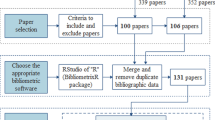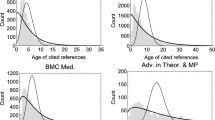Abstract
Stationary distributions, i.e. distributions involving no time dependence, are considered. It is shown that all these distributions in scientometrics can be approximated by the Zipf distribution at high values of variables. The sample moments appear to depend significantly on the sample size. Accordingly, the approximation of these observational data by probability distributions converging to a stable distribution different from the normal one proves to be the only correct approximation. The conclusion is formulated that the use of non-Gaussian statistics is necessary in the science of science and other social sciences.
Similar content being viewed by others
Explore related subjects
Discover the latest articles and news from researchers in related subjects, suggested using machine learning.Notes and References
S. D. HAITUN. Stationary scientometric distributions. Part I. The different approximations,Scientometrics 4 (1982) 5.
For example, see: M. G. BULMER. On fitting the Poisson log-normal distribution to species-abundance data,Biometrics 30 (1974) 101–110; H. S. SICHEL. On a distribution law for word frequencies,J. Amer. Statistical Association 70 (1975) (352, part 1) 542–547; I. K. RAVICHANDRA RAO. The distribution of scientific productivity and social change,J. Amer. Soc. Inform. Sci. 31 (1980) 111–122.
D. J. de S. PRICE. The productivity of research scientists, in:Yearbook of Science and the Future 1975, Encyclopedia Britanica, Inc., Chicago, Toronto et al., 1974.
In a recent paperPrice [see: D. J. de S. PRICE. A general theory of bibliometric and other cumulative advantage processes,J. Amer. Soc. Inform. Sci. 27 (1976) 292–306] prefers beta-function.
A. I. YABLONSKY, Stokhasticheskiye modeli nauchnoy deyatelnosti (Stochastic models of research activities, in:Sistemnye issledovaniya. Yezhegodnik — 1975 (Systems Research, Yearbook — 1975), Moscow, 1976, p. 5–42; A. I. YABLONSKY, On fundamental regularities of the distribution of scientific productivity,Scientometrics 2 (1980) 3–34.
B. MANDELBROT, The variation of certain speculative prices,J. Business 36 (1963) 394–419; B. MANDELBROT. New methods in statistical economics,J. Political Economy 71 (1963) 421–440.
Scarrott [See: G. SCARROTT. Will Zipf join Gauss?New Scientist 62 (1974) 402–404] says: Zipf distribution “may be just as fundamental — and perhaps as importent — as other statistical relationships such as Gaussian distributions”. But his thesis is only verbal.
A. A. IGNATYEV, A. I. YABLONSKY. Analiticheskiye struktury nauchnoy kommunikatsiyi (Analytic structures of scientific communication), in:Sistemnye issledovaniya. Yezhegodnik — 1975 (Systems Research, Yearbook — 1975), Moscow, 1976, p. 64–81.
G. U. YULE,A Statistical Study of Vocabulary. Cambridge. England, Univ. Press, 1944.
B. MANDELBROT, op. cit., note 6.
N. CHOMSKY, J. A. MILLER, Finitary models of language users, in:Handbook Mathematical Psychology, Vol. 2, Wiley, New York, 1963, p. 419–491.
A. I. YABLONSKY, op. cit., note 5, Stokhasticheskiye modeli nauchnoy deyatelnosti (Stochastic models of research activities, in:Sistemnye issledovaniya. Yezhegodnik — 1975 (Systems Research, Yearbook — 1975), Moscow, 1976, p. 5–42.
A. I. YABLONSKY, 1976, op. cit., note 5, Stokhasticheskiye modeli nauchnoy deyatelnosti (Stochastic models of research activities, in:Sistemnye issledovaniya. Yezhegodnik — 1975 (Systems Research, Yearbook — 1975), Moscow, p. 5–42.
S. D. HAITUN, op. cit., note 1,.
B. MANDELBROT, op. cit., note 6,.
N. CHOMSKY, J. A. MILLER, op. cit., note 11.
A. I. YABLONSKY, 1976, op. cit., note 5, Stokhasticheskiye modeli nauchnoy deyatelnosti (Stochastic models of research activities, in:Sistemnye issledovaniya. Yezhegodnik — 1975 (Systems Research, Yearbook — 1975), Moscow, p. 5–42.
Ibid. A. I. YABLONSKY, 1976, Stokhasticheskiye modeli nauchnoy deyatelnosti (Stochastic models of research activities, in:Sistemnye issledovaniya. Yezhegodnik — 1975 (Systems Research, Yearbook — 1975), Moscow, p. 5–42.
See: V. M. KALININ, O statistike literaturnogo teksta (Statistics of literary text),Voprosy yazykoznaniya, 1965, No. 1, p. 123–127; I. A. BOLSHAKOV, Statisticheskiye otsenki otdelnykh parametrov chastotnykh slovarey (Statistical estimation of frequency vocabulary parameters),Nauchno-tekhnicheskaya informatsiya, Ser. 2, (1972) No. 11; I. LIKES. Estimation of probability pr (a<x<b) for a Pareto distribution.Statistische Hefte, (1972), No. 3, 291–297.
YU. V. PROKHOROV, YU. A. ROZANOV,Teoriya veroyatnosti (Probability Theory), Moscow, 1973.
A. I. YABLONSKY, op. cit., note 5 Stokhasticheskiye modeli nauchnoy deyatelnosti (Stochastic models of research activities, in:Sistemnye issledovaniya. Yezhegodnik — 1975 (Systems Research, Yearbook — 1975), Moscow, 1976, p. 5–42.
M. G. KENDALL, Natural law in the social sciences,J. Royal Statistical Society 124 (1961) 4–16.
A. I. YABLONSKY, op. cit., note 5 Stokhasticheskiye modeli nauchnoy deyatelnosti (Stochastic models of research activities, in:Sistemnye issledovaniya. Yezhegodnik — 1975 (Systems Research, Yearbook — 1975), Moscow, 1976, p. 5–42.
A. A. IGNATYEV, A. I. YABLONSKY, op. cit., note 8 Analiticheskiye struktury nauchnoy kommunikatsiyi (Analytic structures of scientific communication), in:Sistemnye issledovaniya. Yezhegodnik — 1975 (Systems Research, Yearbook — 1975), Moscow, 1976, p. 64–81.
A. I. YABLONSKY, 1976, op. cit., note 5, Stokhasticheskiye modeli nauchnoy deyatelnosti (Stochastic models of research activities, in:Sistemnye issledovaniya. Yezhegodnik — 1975 (Systems Research, Yearbook — 1975), Moscow, p. 5–42.
A. A. IGNATYEV, A. I. YABLONSKY, op. cit., note 8, Analiticheskiye struktury nauchnoy kommunikatsiyi (Analytic structures of scientific communication), in:Sistemnye issledovaniya. Yezhegodnik — 1975 (Systems Research, Yearbook — 1975), Moscow, 1976, p. 64–81.
B. V. GNEDENKO, K teorii predelnykh teorem dlya summ nezavisimykh sluchaynykh velichin (Limiting Theorems for Sums of Independent Random Variables), —Izv. AN SSSR, Ser. matem., (1939) 181–232; 643–657.
W. DOEBLIN. Sur l'ensemble de puissonces d'une loi de probabilité,Studia Math. 9 (1940) 71–96.
I. A. IBRAGIMOV, YU. V. LINNIK.Nezavisimiye i statsionarno svyzsanniye sluchayniye velichiny (Independent and Stationary Dependent Random Variables), Moscow 1965.
YU. V. PROKHOROV, YU. A. ROZANOV, op. cit., note 20,Teoriya veroyatnosti (Probability Theory), Moscow, 1973.
S. D. HAITUN, op. cit., note 1. Further, when we shall reference to part I of our paper we shall not reference this paper in Notes.
A. J. LOTKA, The frequency distribution of scientific probability,J. Wash. Academy of Science 16 (1926) 317–323;Scientific and Technical Translating and other Aspects of the Language Problem, UNESCO, Geneva, 1958; D. J. URQUHART, Use of scientific periodicals. in:International Conference on Scientific Information, Wash., 1958, p. 277–290; R. E. BURTON, Citations in American engineering journals. I. Chemical engineering,American Documentation 10 (1959) 70–73; II. Mechanical engineering, 135–138; III. Metallurgical engineering, 209–213; B. BERELSON.Graduate Education in the United States, McGraw-Hill Book Co., New York, 1960, p. 55; M. G. KENDALL, The bibliography of operational research,Operational Research Quartely 11 (1960) 31–36; J. H. WESTBROOK, Identifying significant research,Science 132 (1960) 1229–1234; D. J. de S. PRICE,Little Science, Big Science, Columbia Univ. Press. New York-London, 1963; D. J. de S. PRICE, D. de B. BEAVER, Collaboration in an invisible college,American Psychologist 21 (1966) No. 11; Z. B. BARINOVA et al., Izucheniye nauchnykh zhurnalov kak kanalov svyazi. Otsenka vklada, vnosimogo otdelnymi stranami v mirovoy nauchniy informatsionniy potok (Scientific journals as channels of communications. National contributions to the world flow of scientific information),Nauchno-tekhnicheskaya informatsiya, Ser. 2, (1967) No. 12, 3–11; YU. P. ADLER, YU. V. GRANOVSKY, Z. M. MULCHENKO, Statisticheskiy analiz publikatsiy po planirovaniyu eksperimenta (Statistical analysis of publications on experimental design), in:Novie idei v planirovanii eksperimenta (New ideas in Experiment Design), Moscow, 1969, p. 315–334; Jr. J. E. C. CRAIG, Characteristics of use of geology literature,College and Research Library 30 (1969) 230–236; V. V. NALIMOV, Z. M. MULCHENKO.Naukometriya. Izucheniye razvitiya nauki kak informatsionnogo protsessa (Scientometrics. The Study of Science as an Information Process), Moscow, 1969;Nauka segodnya (Science Today). Moscow, 1969; E. GARFIELD, Citation indexing for studying science,Nature 227 (1970) 669–771; Ye. D. GRAZHDANNIKOV, A. I. SHCHERBAKOV,Elementarnoye vvedeniye v naukometriyu (Elementary Introduction to Scientometrics). Novosibirsk, 1970; D. M. MEKHTIEV, A. M. BABAEV, A. M. RUSTAMOV,Ukazatel tsitirovannoy literatury po neftyanoy nauke i tekhnike U Ts L — neft (Citation Analysis of Publications in the Science and Technology of Oil), Vol. 1, 2, Baku, 1971; S. NARANAN, Power law relation in science bibliography: a selfconsistent interpretation,J. Documentation 27 (1971) 83–97; E. GARFIELD, Citation analysis as a tool in journal evaluating,Science 178 (471–479); J. E. ROECKELEIN. Eponymy in psychology,American Psychologist 27 (1972) 657–659;Science Indicator 1972. Report of the National Science Board. Gov. Print. Off., Wash., 1973; J. VLACHY, Variable factors in scientific communities (Observations on Lotka's law),Theorie a metoda 4 (1972) 91–120; A. POPE, Bradford's law and the periodical literature of information science,J. Amer. Soc. for Inform. Sci. 26 (1975) 207–212; YE. S. KASHFUTDINOVA, F. YE. GRISHINA, M. N. MYALDIZINA, Zakonomernosti rasseyaniya i stareniya informatsii v izuchenii zaprashivaemosti zhurnalov (Characteristics of dissemination and obsolescence of information in technical journals),Elektrotekhnicheskaya promyshlennost, Obshcheotraslevye voprosy, (1976) No. 11, 26–29; E. GARFIELD, The 250 most cited primary authors, 1961–1975. Part I. How the names were selected,Current Contents, (1977) No. 49, 5–15; Part II. The correlation between citations, Nobel prizes, and academy memberships, No. 50, 5–15; Part III. Each author's most cited publication. No. 51, 5–20; M. K. KNYAZEVA, Viyavleniye istochnikov, sostavlyayushchikh “Yadro” izdaniy po tematike vyborki (Characteristics of dissemination of information),Nauchno-tekhnicheskaya informatsiya, Ser. 1, (1977) No. 7, 25–29.
See: S. D. HAITUN, Scientometric investigations in the USSR,Scientometrics 2 (1980) 65–84.
For example, see: H. T. DAVIS.The Analysis of Economic Time Series. The Principia Press Inc., Bloomington, Indiana, 1941; G. K. ZIPF.Human Behaviour and the Principle of Least Effort. Alisson Wesley, Cambridge, Mass., 1949; F. A. HAIGHT, Some statistical problems in connection with word association data. —J. Mathematical Psychology 3 (1966) 217–233; N. CHOMSKY, J. A. MILLER, op. cit., note 11 Finitary models of language users, in:Handbook Mathematical Psychology, Vol. 2, Wiley, New York, 1963, p. 419–491; R. A. FAIRTHORNE, Empirical hyperbolic distribution (Bradford-Zipf-Mandelbrot) for bibliometric description and prediction,J. Documentation 25 (1969) 319–343; S. NARANAN, op. cit., note 32, Power law relation in science bibliography: a selfconsistent interpretation,J. Documentation 27 (1971) 83–97; A. J. YABLONSKY, op. cit., note 5, Stokhasticheskiye modeli nauchnoy deyatelnosti (Stochastic models of research activities, in:Sistemnye issledovaniya. Yezhegodnik — 1975 (Systems Research, Yearbook — 1975), Moscow, 1976, p. 5–42.
For example, see: J. AITCHISON, J. A. C. BROWN,The Lognormal Distribution. Univ. Press, Cambridge, 1957; O. LANGE,Introduction to Econometrics. Macmillan, New York, Scientific Publishers, 1962, Russian translation M., 1964.
For example, see: J. O. IRWIN, The generalized Warring distribution applied to accident theory,J. Royal Statistical Society, Ser. A, 131 (1968), part, 2, 205–225; 138 (1975) part 2, 204–227; 138 (1975) part 3, 374–384.
H. T. DAVIS, op. cit., note 34,.
J. C. WILLIS,Age and Area. Univ. Press, Cambridge, 1922; H. T. DAVIS, op. cit., note 34,The Analysis of Economic Time Series. The Principia Press Inc., Bloomington, Indiana, 1941; G. U. YULE, M. G. KENDALL,An Introduction to the Theory of Statistics, 14th ed., Griffin, London, 1950; C. E. SHENNON, Prediction and entropy of printed English,Bell System Technical J. 30 (1957) 50–64; P. E. HART, S. J. PRAIS. The analysis of business concentration: a statistical approach,J. Royal Statistical Society a-119 (1956) 150–180; P. E. HART, E. H. BROWN, The sizes of trade unions: a study of the laws of aggregation,The Economic J. 67 (1957) 1–15; M. G. KENDALL, A. STUART,The Advanced Theories of Statistics. Vol. 2.Inference and Relationship. Griffith, London, 1958; M. LOEVE,Probability Theory. D. Van Nonstrand Co. Inc., New York, 1960; A. K. MITROPOLSKY,Tekhnika statisticheskikh vychislenii (Statistics), Moscow, 1961; B. V. GNEDENKO,Kurs teorii veroyatnostey (Probability Theory), Moscow, 1961; O. LANGE, op. cit., note 35,Introduction to Econometrics. Macmillan, New York, Scientific Publishers, 1962, Russian translation M., 1964; YE. S. VENTSEL,Teoriya veroyatnosti (Probability Theory), Moscow, 1962; C. GINI,Le Medie, Unione Tipografico-Editrico Torinese, Milano, 1963; P. L. HENNEQUIN, A. TORTRAT,Theorie des probabilites et quelques. Masson, Paris, 1965; N. V. SMIRNOV, I. V. DUDIN-BARKOVSKY.Kurs teoriyi veroyatnosti i matematicheskoy statistiki dlya tekhnicheskikh prilozheniy (Theory of Probability and Statistics and its Applications in Technology). Moscow, 1965; W. FELLER,Introduction to Probability Theory and its Applications. Vol. 1–2. Wiley, New York, 1966; N. RAVER, Performance of IR systems, in:Information Retrieval: a Critical View. Thompson, Wash., 1967, p. 131–142; O. LANGE, A. BANASINSKY,Teoria Statistiki. Panstwowe wydawnictwo ekonomiczne. Warszawa, 1970; Z. M. MULCHENKO, YU. V. GRANOVSKY, A. D. STRAKHOV, O naukometricheskikh kharakteristikhakh informatsionnoy deyatelnosti vedushchikh uchyonykh (Scientometric parameters of information activities by great scientists), in:Problemy udovletvoreniya informatsionnykh potrebnostey (Problems of Measurement Covering Information Needs), Moscow, 1974, p. 127–147; E. M. MONTROLL, W. W. BADGER,Introduction to quantitative aspects of social phenomena, New York, Gordon and Breach Science Bull., 1974;Narodnoye khozyaystvo SSSR v 1975 g. (Economics of the USSR in 1975). Moscow,Statistika, 1976; Chastotniy slovar russkogo yazyka (Frequency Vocabulary of Russian language). Moscow, 1977.
Author information
Authors and Affiliations
Rights and permissions
About this article
Cite this article
Haitun, S.D. Stationary scientometric distributions. Scientometrics 4, 89–104 (1982). https://doi.org/10.1007/BF02018448
Received:
Revised:
Issue Date:
DOI: https://doi.org/10.1007/BF02018448




